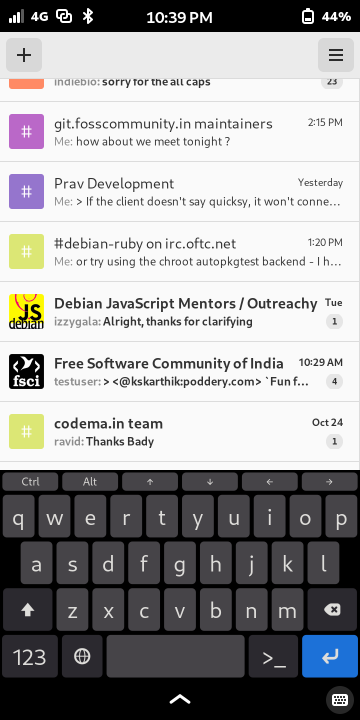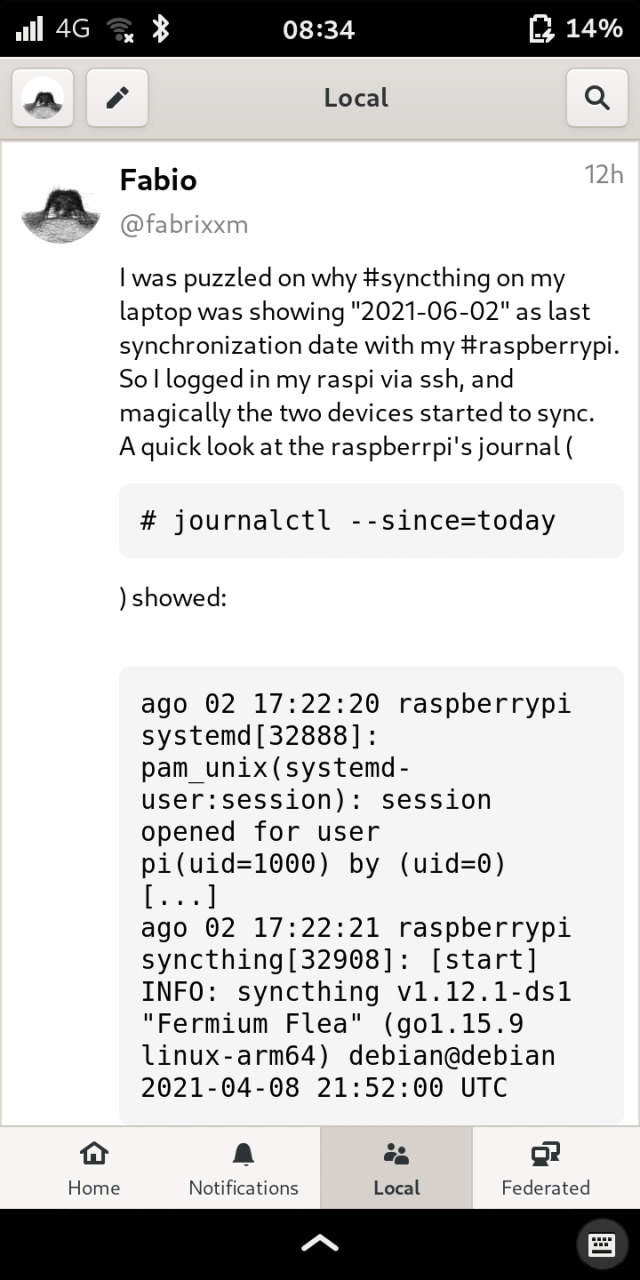Posted on February 15, 2023
I’ve had and used
1 a PinePhone for quite some time now, and a shiny new blog sounds like a good time to do a review of my experience.
TL;DL: I love it, but my use cases may not be very typical.
While I’ve had a mobile phone since an early time (my parents made me carry one for emergencies before it was usual for my peers) I’ve never used a typical smartphone (android / iPhone / those other proprietary things) because I can’t trust them not to be designed to work against me (data collection, ads, tricking users into micro payments, and other antipatterns of proprietary software design), and bringing them to sanity as most of the people I know do is too much effort for my tastes.
Instead, as a phone I keep using an old nokia featurephone
2 which is reliable, only requires charging once a week, and can easily survive falling from hand height to the ground, even if thrown
3.
And then I’ve been carrying a variety of other devices to do other computer-like tasks; earlier it was just a laptop, or a netbook, a Pandora (all of which used a dongle to connect to mobile network internet) then I tried a phone with FirefoxOS (it could have been better) and now the PinePhone has taken their place, at least when I’m not carrying a laptop anyway.
So, the tasks I use the PinePhone for are mostly:
- sending and receiving xmpp messages, with no need for notifications (when somebody needs to tell me something where urgency is required, they know to use the other phone, either with a call or an sms);
- tethering an internet connection to the laptop;
- reading djvu scans of old books while standing in a queue or something;
- checking something on the internet when I’m not close to a real computer (i.e. one with a keyboard and a big screen);
- running a timer while heat-setting fabric paint with an iron (and reading a djvu book at the same time — yes, this is a very specific task, but it has happened multiple times already :D );
- running a calculator with unit conversions;
- running the odd command line program;
- taking pictures, especially those that I want to send soon (I often also carry a DSLR camera, but I tend to wait a few days before I download them from the card);
- map related things.
3 and 5 work perfectly well, no issues there. 1, 2 and 4 usually work just fine, except for the fact that sometimes while the phone is suspended it forgets about being a phone, and needs to be restarted to turn the modem back on. It’s not a big deal while using the phone, I just need to check before I try to use it after a few hours.
For 1, I also had to take care to install dino-im from experimental, as up to now the features required to fit the interface in a mobile screen aren’t available in the official release, but I believe that this has just been fixed.
Somewhat related to 4, I’ve also installed kiwix and the dumps of wiktionary and wikivoyage, but I haven’t had a chance to travel much, so I’m not really using it.
For 6 I’m quite happy with qalculate, the GUI version of qalc (which is what I use on my laptop), even if it has a few minor interface issues, and 7 of course works as well as it can, given the limitations of a small screen and virtual keyboard.
8 is, let us say, problematic. The camera on the PinePhone is peculiar, only works with a specific software, and even there the quality of the pictures is, well, low-fi, vintagey pictures are a look and that’s a specific artistic choice, right? Thanks to the hard work of the megapixels maintainer the quality has improved a lot, and these days it is usable, but there are still limits (no webcam in the browser, no recording of videos).
9 is really bad. A few times I can remember getting a GPS fix. A few times in many months, and now and then I keep trying, to see if a miracle has happened, but usually I only get a vague position from wifi data (which isn’t great, when walking through less densely populated areas).
I’ve seen another PinePhone running gpsd and getting data from an external GPS receiver via bluetooth, and if I really needed it I may seriously consider that solution.
Also, the apps available in mobian aren’t great either, even when compared to running tangogps on an OpenMoko with pre-downloaded maps (I mean! I don’t think my expectations are too high!).
I’ve heard that PureMaps is quite good as a software, but a bit of a PITA to package for Debian, and I really hope that one day there will be a linux-first mobile device with good GPS hardware, so that people will be encouraged to fix the software side.
Thankfully, I don’t usually
need GPS and navigation software; when I’m driving into places I don’t know I usually have a human navigator, and when walking into places I can do with just a static map (either printed on paper or on the PinePhone), maybe some pre-calculated route from the OSM website and looking at street names to find out where I am.
Overall, for my use cases the PinePhone works just fine and is an useful addition to the things I always carry with me, and I don’t feel the pressing need to get an android phone. I don’t think it’s ready as a daily driver for everybody, but I think that depending on one’s needs it’s worth asking around (I’d recommend doing so on the fediverse with a #
PinePhone and #
mobian hashtag), as there is a non-zero chance that it may be a good fit for you.
- which, if I’m not mistaken, is often not implied by the fact of owning it :D↩︎
- for very low values of feature: it doesn’t have any kind of internet access, and there are only 3 games, one of which is snake.↩︎
- don’t ask.↩︎
https://blog.trueelena.org/blog/2023/02/15-my-experience-with-a-pinephone/index.html



